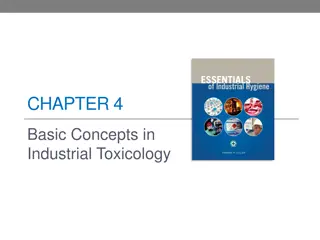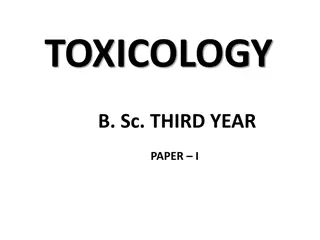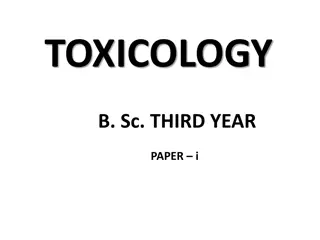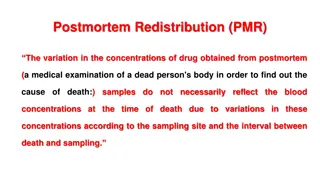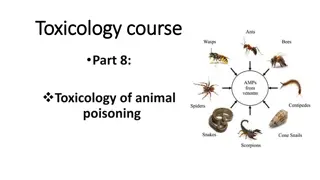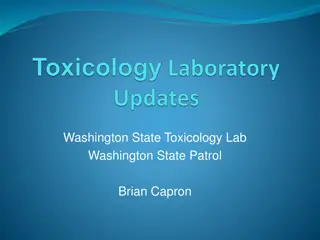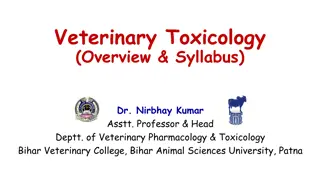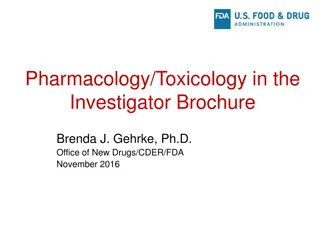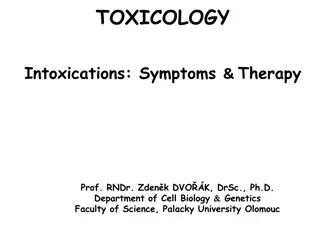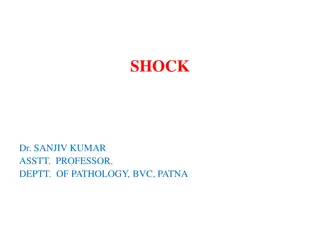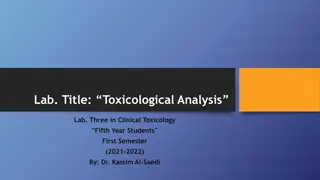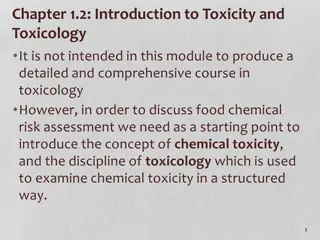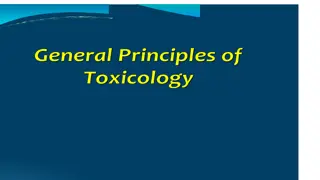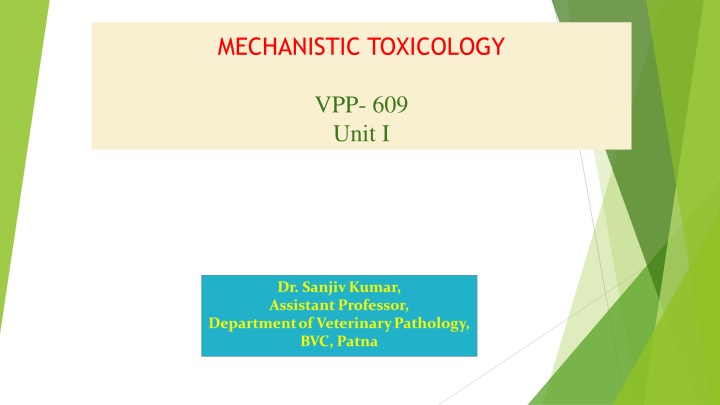
Mechanisms of Toxicity in Living Organisms
Mechanistic toxicology involves studying how chemical or physical agents interact with living organisms to cause toxicity. Understanding these mechanisms is crucial for prevention, treatment, and designing safe chemicals. It plays a key role in various fields such as regulatory setting of safe exposure limits, remediation of contaminated sites, drug development, and forensic toxicology. Pharmacokinetics, describing the time relationships for absorption, distribution, metabolism, and elimination of chemicals, also plays a significant role in determining toxicity outcomes.
Download Presentation

Please find below an Image/Link to download the presentation.
The content on the website is provided AS IS for your information and personal use only. It may not be sold, licensed, or shared on other websites without obtaining consent from the author. If you encounter any issues during the download, it is possible that the publisher has removed the file from their server.
You are allowed to download the files provided on this website for personal or commercial use, subject to the condition that they are used lawfully. All files are the property of their respective owners.
The content on the website is provided AS IS for your information and personal use only. It may not be sold, licensed, or shared on other websites without obtaining consent from the author.
E N D
Presentation Transcript
MECHANISTIC TOXICOLOGY VPP- 609 Unit I
Introduction Mechanistic toxicology is the study of how chemical or physical agents interact with living organisms to cause toxicity. Knowledge of the mechanism of toxicity of a substance enhances the ability to prevent toxicity and design more desirable chemicals; it constitutes the basis for therapy upon overexposure, and frequently enables a further understanding of fundamental biological processes.
Why Understand Mechanisms of Toxicity? Understanding the mechanism by which a substance causes toxicity enhances different areas of toxicology in different ways. Mechanistic understanding helps the governmental regulator to establish legally binding safe limits for exposure. It helps toxicologists in recommending courses of action regarding clean-up or remediation of contaminated sites and, along with physical and chemical properties of the substance or mixture, can be used to select the degree of protective equipment required. Mechanistic knowledge is also useful in forming the basis for therapy and the design of new drugs for treatment of human disease.
For the forensic toxicologist the mechanism of toxicity often provides insight as to how a chemical or physical agent can cause death or incapacitation. If the mechanism of toxicity is understood, descriptive toxicology becomes useful in predicting the toxic effects of related chemicals. It is important to understand, however, that a lack of mechanistic information does not deter health professionals from protecting individual health.
Role of Pharmacokinetics in Toxicity Pharmacokinetics describes the time relationships for chemical absorption, distribution, metabolism (biochemical alterations in the body) and elimination or excretion from the body (ADME). Relative to mechanisms of toxicity, these pharmacokinetic variables can be very important and in some instances determine whether toxicity will or will not occur. For instance, if a material is not absorbed in a sufficient amount, systemic toxicity (inside the body) will not occur.
Conversely, a highly reactive chemical that is detoxified quickly (seconds or minutes) by digestive or liver enzymes may not have the time to cause toxicity. Some polycyclic halogenated substances and mixtures as well as certain metals like lead would not cause significant toxicity if excretion were rapid; but accumulation to sufficiently high levels determines their toxicity since excretion is not rapid (sometimes measured in years).
Fortunately, most chemicals do not have such long retention in the body. Accumulation of an innocuous material still would not induce toxicity. The rate of elimination from the body and detoxication is frequently referred to as the half-life of the chemical, which is the time for 50% of the chemical to be excreted or altered to a non- toxic form.
Basics Toxicology is "the science of poisons." As our understanding of how various agents can cause harm to individual and other organisms, a more descriptive definition of toxicology is "the study of the adverse effects of chemicals or physical agents on living organisms". Adverse effects may occur in many forms, ranging from immediate death to subtle changes not realized until months or years later.
They may occur at various levels within the body, such as an organ, a type of cell, or a specific biochemical. Knowledge of how toxic agents damage the body has progressed along with medical knowledge. It is now known that various observable changes in anatomy or body functions actually result from previously unrecognized changes in specific biochemicals in the body
Xenobiotic is the general term that is used for a foreign substance taken into the body. It is derived from the Greek term xeno which means "foreigner." Xenobiotics may produce beneficial effects (such as a pharmaceuticals) or they may be toxic (such as lead). As Paracelsus proposed centuries ago, dose differentiates whether a substance will be a remedy or a poison. A xenobiotic in small amounts may be non-toxic and even beneficial but when the dose is increased, toxic and lethal effects may result.
Toxicant, toxin, and poison are often used interchangeably in the literature; however, there are subtle differences as indicated in the table. Toxic substances may be systemic toxins or organ toxins. A systemic toxin is one that affects the entire body or many organs rather than a specific site. For example, potassium cyanide is a systemic toxicant in that it affects virtually every cell and organ in the body by interfering with the cell's ability to utilize oxygen.
Toxicants may also affect only specific tissues or organs while not producing damage to the body as a whole. These specific sites are known as the target organs or target tissues. Some examples: Benzene is a specific organ toxin in that it is primarily toxic to the blood-forming tissues. Lead is also a specific organ toxin; however, it has three target organs (central nervous system, kidney, and hematopoietic system).
Dose by definition is the amount of a substance administered at one time. However, other parameters are needed to characterize the exposure to xenobiotics. The most important are the number of doses, frequency, and total time period of the treatment. There are numerous types of doses, e.g., exposure dose, absorbed dose, administered dose and total dose.
Dose-response relationship: The dose-response relationship is a fundamental and essential concept in toxicology. It correlates exposures and the spectrum of induced effects. Generally, the higher the dose, the more severe the response. The dose-response relationship is based on observed data from experimental animal, human clinical, or cell studies.
The point at which toxicity first appears is known as the threshold dose level. A threshold for toxic effects occurs at the point where the body's ability to detoxify a xenobiotic or repair toxic injury has been exceeded. For most organs there is a reserve capacity so that loss of some organ function does not cause decreased performance.
For example, the development of cirrhosis in the liver may not result in a clinical effect until over 50% of the liver has been replaced by fibrous tissue. The dose-response curve normally takes the form of a sigmoid curve. It conforms to a smooth curve as close as possible to the individual data points. For most effects, small doses are not toxic.
Dose-response curves are used to derive dose estimates of chemical substances. A common dose estimate for acute toxicity is the LD50 (Lethal Dose 50%). This is a statistically derived dose at which 50% of the individuals will be expected to die. LD0 represents the dose at which no individuals are expected to die. This is just below the threshold for lethality. LD10 refers to the dose at which 10% of the individuals will die.
Effective Doses (EDs) are used to indicate the effectiveness of a substance. Normally, effective dose refers to a beneficial effect (relief of pain). It might also stand for a harmful effect. Thus the specific endpoint must be indicated. Two terms often encountered are No Observed Adverse Effect Level (NOAEL) and Low Observed Adverse Effect Level (LOAEL).
Acute toxicity occurs almost immediately (hours/days) after an exposure. An acute exposure is usually a single dose or a series of doses received within a 24 hour period. Death is a major concern in cases of acute exposures. Non-lethal acute effects may also occur, e.g., convulsions and respiratory irritation. Subchronic Toxicity results from repeated exposure for several weeks or months. Examples are: - Ingestion of coumadin tablets (blood thinners) for several weeks as a treatment for venous thrombosis can cause internal bleeding. Chronic Toxicity represents cumulative damage to specific organ systems and takes many months or years to become a recognizable clinical disease.
Damage due to subclinical individual exposures may go unnoticed. With repeated exposures or long-term continual exposure, the damage from these subclinical exposures slowly builds-up (cumulative damage) until the damage exceeds the threshold for chronic toxicity. Ultimately, the damage becomes so severe that the organ can no longer function normally and a variety of chronic toxic effects may result. Examples of chronic toxic affects are: - cirrhosis, chronic kidney disease.


